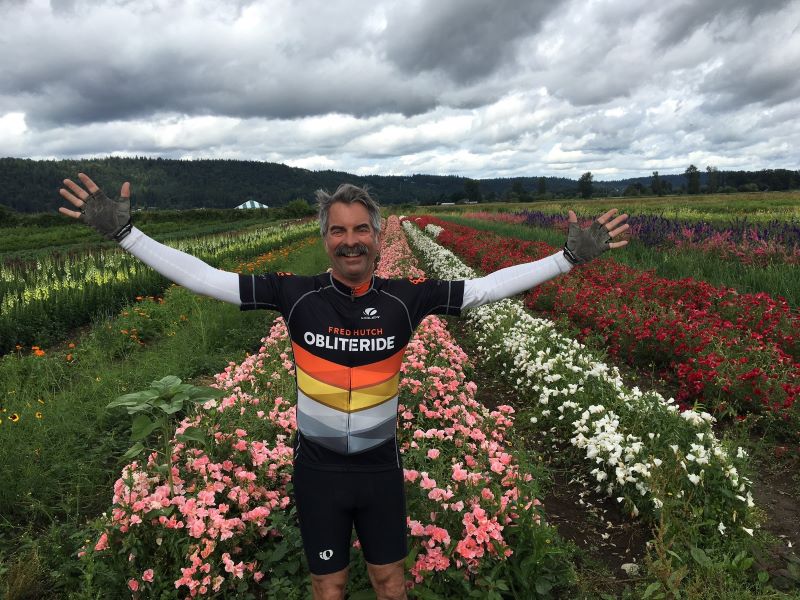
Dr. Radich training for a Obliteride century ride. Photo courtesy of Dr. Radich.
Dr. Radich, a Professor in the Translational Science and Therapeutics Division and the Kurt Enslein Endowed Chair at Fred Hutchinson Cancer Center, reflects on lessons in cowboy medicine, the genetics of luck, and a serendipitous meeting that impacted care for patients with chronic myeloid leukemia (CML) around the world.
Where did you grow up and when did you know you wanted to be a physician? I grew up in Sonoma, California, which was then a small town of about 3,000 people. I lived there for most of my childhood and then moved to Santa Rosa. I’m a small-town guy. My dad is from an immigrant family that came from Yugoslavia. My mom was a “Grapes of Wrath Okie” child, moving slowly from Oklahoma to California while living in government camps, picking crops, etc. My sister was the first on either side of the family to get any college education. I’m the first to do any graduate education.
I was sick a lot as a kid. I had a pretty visceral feeling for what physicians could do. I thought a career caring for people would be good. I liked the idea of doing something empathetic as a career.
The work I do now was never contemplated as a career for anyone I knew when I was growing up, especially me. Like many vaguely coordinated kids, I grew up thinking about playing sports, but I too soon discovered that my night vision was never going to allow me to do that (eg, the curveball). It was clear that using my head was my way to make a living.
During college, medicine was part of the picture, but I wasn’t that intrigued by science at the time. I was into literature and fiction writing. It’s ironic because you can say that what I do now is mostly fiction writing. We think it’s fact now, but 20 years from now, anyone who bothers to read it will say, “What were they thinking?”
Along the line, I became interested in molecular biology and evolution. I went to graduate school for epidemiology and became more interested in medicine. Medicine was a place where I could do science-based work with empathy as the bedrock.
What led you to specialize in hematologic oncology? I knew I wanted to do academic medicine, but it was difficult to decide on the specialty because I liked pulmonary intensive care, infectious disease, and nephrology. I liked oncology because of the basic science.
It seemed like oncology was where everything came together. Oncology was dealing with life and death. There wasn’t a lot of gray area. Oncology was the distillation of all the intense medicine that I liked. Empathy is the touchstone because most things weren’t going to work out well and you had to be both a scientist and a priest.
By the time I got out of medical school, I knew I wanted to do oncology. The question was whether I wanted to do pediatric or adult oncology. I interviewed for residencies in both, and I couldn’t make up my mind. I filled up both match lists, had two FedEx envelopes ready and I flipped a coin. I dropped one envelope in the mailbox and one in the trash. Internal medicine it was.
Was there a particular mentor who shaped your path in medicine? When I was an early second-year resident, I got an elective at the Fred Hutchinson Cancer Center. That was in the 1980s, when bone marrow transplant was in its early days, and Fred Hutch was where it was happening. It was the most amazing place because things were going on there that were not happening anywhere else.
Every day was something new, something that people hadn’t seen before. It was wild. It was like cowboy medicine. We were doing our best, but we were seeing things that people hadn’t described before. It was quite a thing—full of invention, excitement, and an emotional roller coaster. At the end of that rotation, I said, “That’s what I am going to do.”
E. Donnall Thomas, MD, who won the 1990 Nobel Prize in Physiology or Medicine*, was the boss. He was a character to try to emulate because he was a stoic, west Texan gent. He had a singular sense of purpose, an intensely curious and active mind, and an interesting and dry sense of humor. When he started doing bone marrow transplantation, many people thought he was way out there, but he stuck with it and got the Nobel Prize. There was a cool determination that he had about doing things in a stepwise way. He was calm but driven. He was an excellent role model. You just didn’t want to disappoint Don.
What led to your interest in diagnostics and studying what you’ve referred to as the “genetics of luck”? My dad was good with his hands. He was drafted by the St. Louis Cardinals but choose to join the US Army Air Corps. He was a flight engineer on B24s flying over the hump into China during World War II. He was good at MacGyvering things on the fly. At home, what he couldn’t do, he built. When I went to look at labs during the start of my fellowship, I admit that that rather than being interested in biology alone, I was interested in what we could do mechanically to ask our questions.
The lab I worked in had the first polymerase chain reaction (PCR) machine in Seattle, and I broke the first PCR machine in Seattle about eight hours later. I was interested in making things up and designing new assays because it was fun. Eventually, that’s what got me into diagnostics. It was looking at ways to detect disease when everyone else couldn’t see it—the so-called minimal residual disease then—and building a better mousetrap to be able to find a needle in the haystack, that leukemia cell in a background of normal cells.
In one of the first grants I submitted, I wrote something like, “We think if we develop PCR methods to reliably predict relapse, that can be used to define therapies and pharmaceutical endpoints for trials.” That was pure unvarnished grantsmanship, and darned if that didn’t turn out to be what happened. It sounded good at the time, and I probably thought it could happen, but I never could have guessed how far and deep the concept of residual disease would catch on.
You were part of a team that helped to establish the international scale for BCR–ABL1 testing and you worked to develop the first automated assay for BCR–ABL1. What was that process like? The person who pushed standardization the most was my colleague Susan Brandford, PhD, of the University of Adelaide. She did the lion’s share of work. We began using BCR–ABL1 testing in the IRIS trial, which was the first international study of imatinib, the first tyrosine kinase inhibitor in CML. We found that by testing peripheral blood for BCR–ABL1 at the end of 12 months, you could tell who would do well farther on. From that, the field took off. We invented the concept of major molecular remission (MMR), which we defined as a three-log decrease in BCR–ABL1 from diagnosis. It was an ad hoc analysis of the IRIS data, and we made up the term for the New England Journal of Medicine paper, but I don’t think any of us really expected it to stick. As it turns out, when people started doing retrospective analysis on all their phase II studies, the MMR concept worked in predicting long-term success of imatinib.
Sue led the rest of us to design an international scale for BCR–ABL1 testing. It allowed all labs to be set to the same standard so we could compare BCR-ABL1 levels from lab to lab, trial to trial. Each lab had a dummy variable that they would multiply their value by to get to this international scale. The main advantage is we were able to—for the first time—change the natural history of how pharmaceutical trials are done. Subsequent CML trials with the new inhibitors used MMR at 12 months as one of the primary endpoints, changing five- to 10-year overall survival studies to very quick, molecular endpoint trials.
The story behind developing the automated cartridges for testing is filled with twists. The story involves The Max Foundation in Seattle, founded and led by Pat Garcia-Gonzalez. Her son, Max, died because they couldn’t find a bone marrow transplant donor for him (this was before the introduction of imatinib). She started the foundation as an outreach, education, and support organization for patients with CML in low-resource countries, starting in Central and South America.
Once imatinib was approved, she went to Novartis, the manufacturer of the drug. They came to an agreement that if Garcia-Gonzalez could diagnose patients with CML in a place in the world where they didn’t have the drug, they would give that patient the drug for life.
A volunteer from The Max Foundation was setting up their computer system and Pat was lamenting that she had these patients in Central America who she believed had had CML, but she couldn’t prove it. She couldn’t test them, as no local facilities could even do the most basic of diagnostic tests. The volunteer told her to come speak with me.
It turns out that volunteer was a patient who had CML whom I transplanted 10 years before. He and I kept in touch. From that, we started doing testing for CML, first in patients from El Salvador. They would get us blood samples, we tested the samples, and patients would receive the drug if they had CML.
We then tried to partner with the foundation to set up labs in various countries, which turned out to be difficult because many places didn’t have reliable electricity and you can’t get the reagents into the labs. We needed another way to test.
Around that time, Cepheid approached me about cartridge assays. At the time they were a company testing for bioterrorism pathogens, starting after the anthrax attack in 2001. One of their main technologists came to work in my lab for three years, and we developed a cartridge assay for BCR–ABL1. That was cool, but what’s even cooler is at about the same time, Cepheid developed cartridge assays for tuberculosis, HIV, and other diseases. The World Health Organization backed them and started paying to place Cepheid machines in the field all over the world. We were able to piggyback on that. Cepheid donated cartridges to The Max Foundation to put CML testing around the globe.
The Max Foundation now takes care of about 60,000 to 80,000 patients with CML worldwide. They receive free treatment and testing. If you look at those patients, they have the same lifespan as newly diagnosed patients in Seattle. This is a remarkable arc of a story that arose from luck and happenstance.
What are your favorite hobbies and activities outside of work? I play almost any sport with a ball, road bike, and ran a lot before a recent knee replacement. Besides work, my perfect day would be having an exercise trifecta where I would bike, play tennis, and go play golf.
Is there a skill, hobby, or experience that you’ve had that people might be surprised to know? I am a minister of the Universal Life Church and have done around a dozen weddings. The most curious wedding was an impromptu one. I was at a wedding where the minister never showed up, so I officiated an Amish wedding in front of 200 people on the fly. Talk about luck.
Jerald Radich, MD, is a Professor in the Translational Science and Therapeutics Division and the Kurt Enslein Endowed Chair at Fred Hutchinson Cancer Center.
*The prize was awarded jointly to Joseph E. Murray and E. Donnall Thomas.
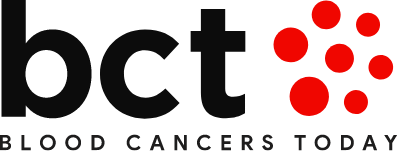
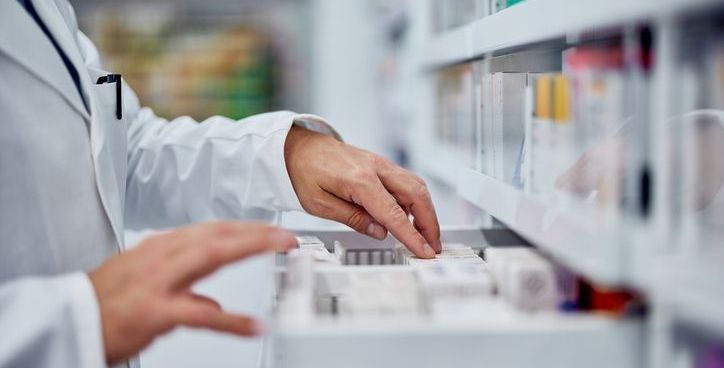
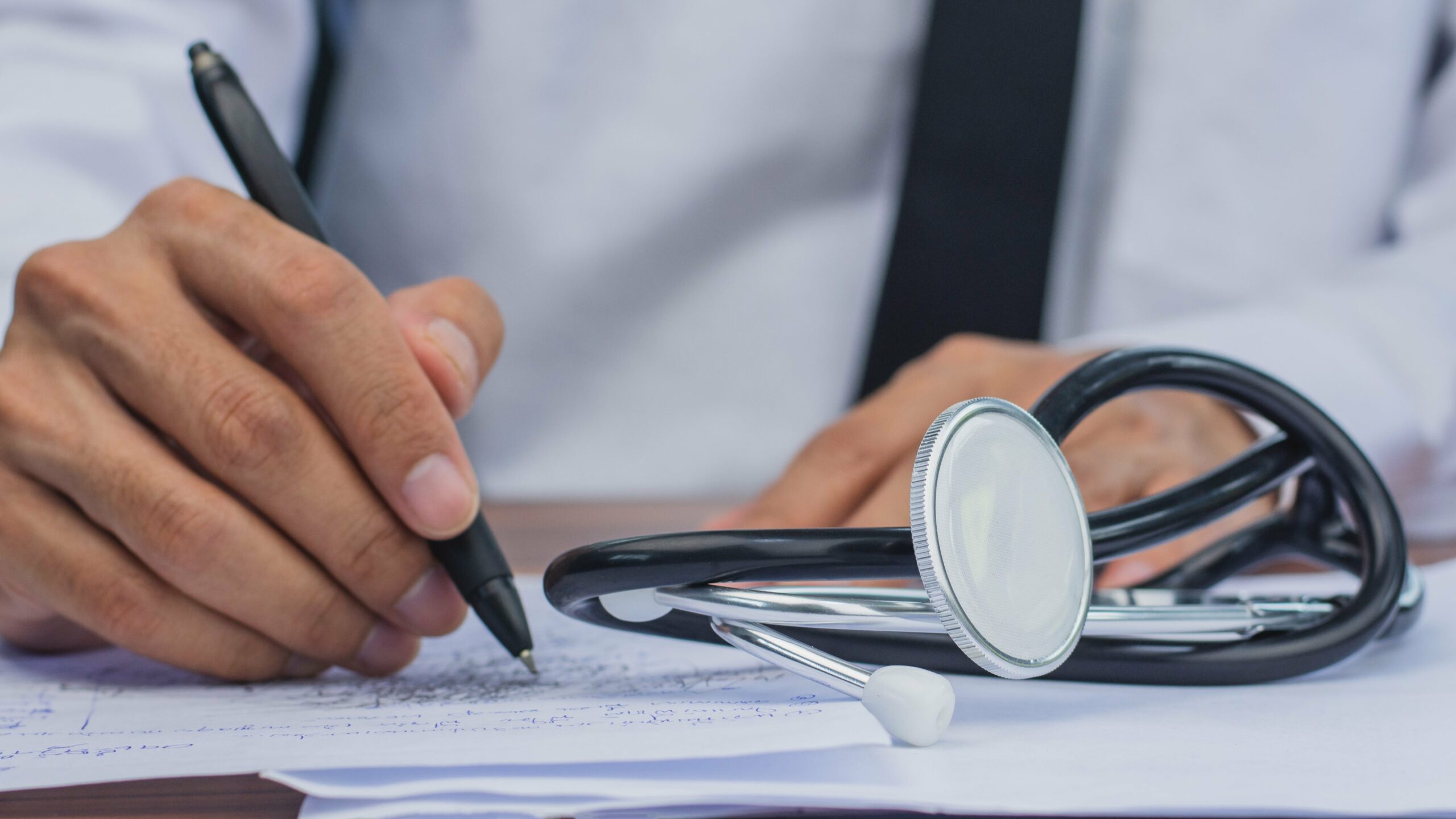
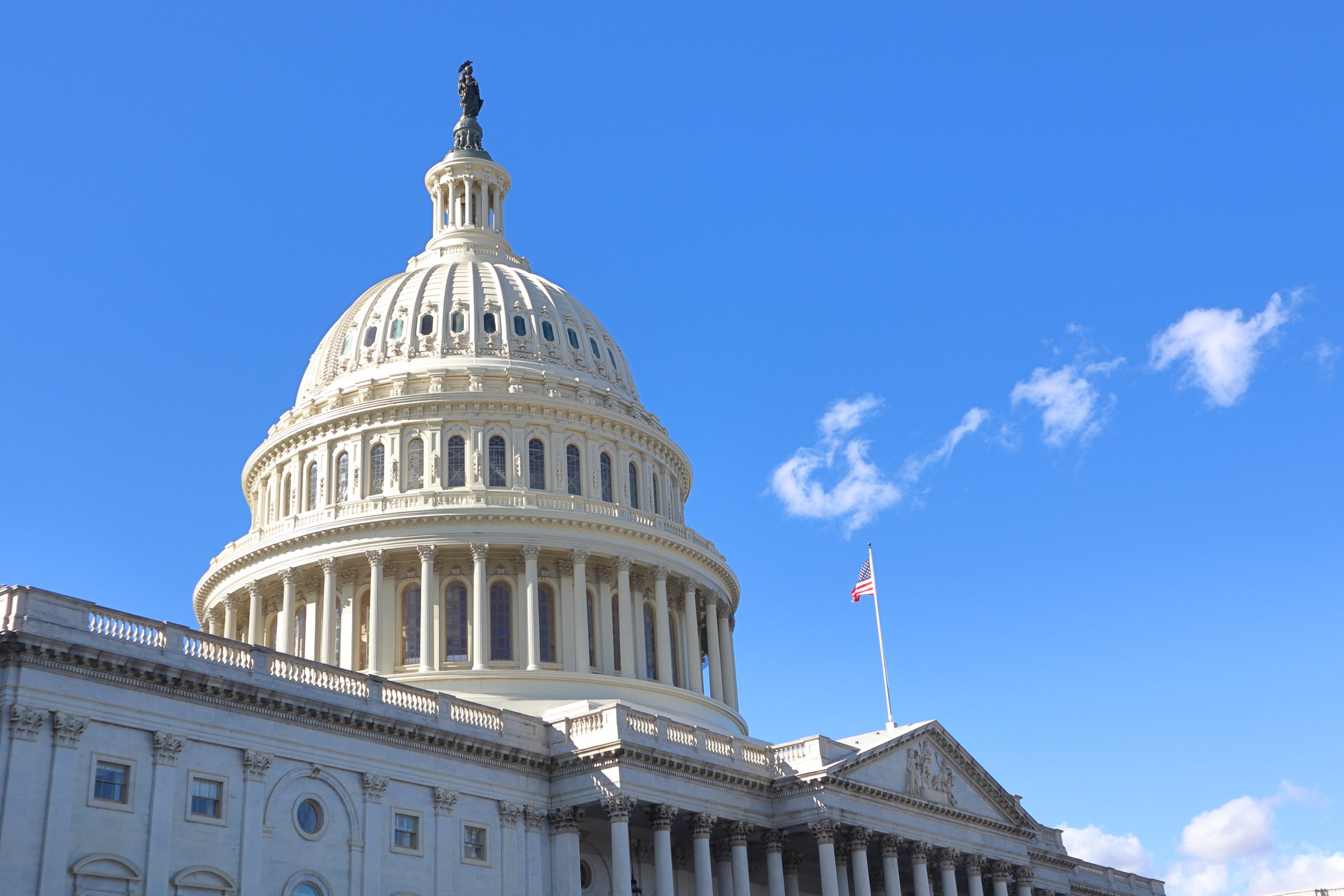
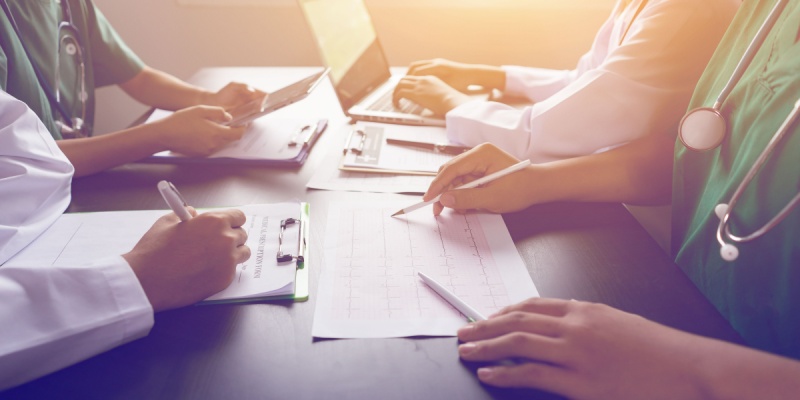
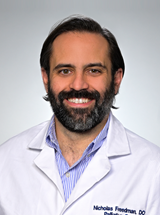
 © 2025 Mashup Media, LLC, a Formedics Property. All Rights Reserved.
© 2025 Mashup Media, LLC, a Formedics Property. All Rights Reserved.